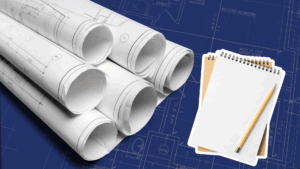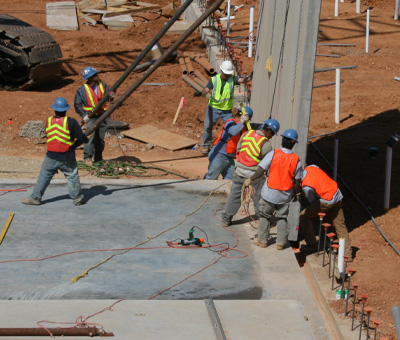The construction sector is undergoing a significant transformation, propelled by the integration of Artificial Intelligence (AI). This integration is not merely an addition to the toolbox; it is a revolutionary force that is reshaping the planning, execution, and conception of construction projects.
Current AI Applications Enhancing Construction
The adoption of AI in construction, once slow, is now accelerating, offering a broad spectrum of applications that enhance project efficiency and precision. For instance, AI-driven predictive analytics are forecasting project timelines and budgets with unprecedented accuracy, while AI-powered robots and drones undertake on-site tasks, elevating both efficiency and safety.
Project management benefits greatly from AI, with algorithms predicting delays or cost overruns, thus enabling more proactive project oversight. Additionally, AI is revolutionizing resource allocation and workforce scheduling, ensuring optimal use of available resources.
In design and planning, AI-integrated Building Information Modeling (BIM) tools are streamlining architectural and engineering tasks, significantly reducing planning phase durations. These advancements facilitate real-time collaboration among stakeholders, ensuring cohesive project development.
On construction sites, autonomous machinery, such as bulldozers and drones, are being deployed for various tasks, including site surveying and material handling. This not only mitigates human risk in hazardous conditions but also enhances site safety.
AI’s Role in Improving Safety and Efficiency
The integration of AI in construction extends to improving safety standards. AI-powered wearable technologies and drones are monitoring sites for potential hazards, while predictive safety features are preemptively identifying accident risks, substantially reducing workplace incidents.
Moreover, AI’s influence on project efficiency cannot be overstated. From optimizing schedules to recommending the best times for specific activities based on external factors like weather, AI is minimizing disruptions and enhancing project timelines. Additionally, AI contributes to sustainability by optimizing material usage and reducing waste, aligning with global environmental responsibility goals.
Navigating Challenges for AI Integration in Construction
Despite the promising advancements, integrating AI into construction faces several challenges. The complexity of AI systems requires significant R&D investment and an in-depth understanding of construction processes. Moreover, the need for high-quality, consistent data collection is paramount, as AI’s effectiveness heavily relies on the accuracy of input data.
Integrating AI with legacy systems presents another hurdle, necessitating substantial updates or replacements. Furthermore, the construction sector’s AI skills gap demands targeted training and recruitment strategies to ensure the workforce can effectively leverage new technologies.
Privacy and security concerns also loom large, with increased data collection raising the stakes for safeguarding sensitive information against cyber threats.
The Future of AI in Construction
Looking ahead, AI’s potential in construction seems boundless. We anticipate advancements in AI-driven design tools capable of autonomously creating comprehensive building designs, considering environmental impacts, material efficiency, and structural integrity. Predictive maintenance of construction equipment, powered by AI, promises to reduce downtime and maintenance costs significantly.
The future also holds promise for enhanced construction safety through advanced risk assessment and real-time health monitoring via AI-integrated wearables. Furthermore, AI’s role in promoting sustainability and green construction practices is expected to expand, optimizing resource utilization and facilitating the design of energy-efficient buildings.
Conclusion: Embracing the AI Revolution in Construction
The integration of AI in construction is a testament to the transformative power of technology. While challenges remain, the industry’s dedication to overcoming these obstacles is clear. The future of construction with AI promises not only smarter, safer, and more efficient project execution but also a commitment to sustainability and innovation.
As the construction industry stands on the brink of this new era, the synergy between AI and human expertise is set to unlock remarkable achievements. The focus now shifts to intelligently and sustainably constructing the future, leveraging AI not just as a technological achievement but as a cornerstone for building the world of tomorrow.
Building Safety from the Start with Prevention Through Design
In workplace safety, the best results come from stopping hazards before they ever reach employees. While training, procedures, and personal protective equipment (PPE) are important, the most effective approach is to design hazards out of the workplace from the beginning. This approach is known as Prevention through Design (PtD). What is Prevention through Design? Prevention…
Continue Reading Building Safety from the Start with Prevention Through Design
Emergency Preparedness: Staying Ready
Whether a misstep causes a fall or a natural disaster causes an evacuation, emergencies happen. Emergency preparedness and response can mean the difference in avoiding an injury or ending with a fatality. Emergencies come with little to no warning. While we may think these are extreme situations that will “never” happen to us, the reality…
Continuous Improvement and Immersive Training in Action
Construction is a dangerous business. Risks are constant, standards shift, and complacency can be deadly. For Jennifer Lastra, a U.S. Navy veteran and current CEO of 360 Immersive, corporate-style training falls far short. True safety begins with continuous improvement, supported by real engagement on the job. Training Should Go Beyond a Click-Through Box “Corporate training…
Continue Reading Continuous Improvement and Immersive Training in Action











